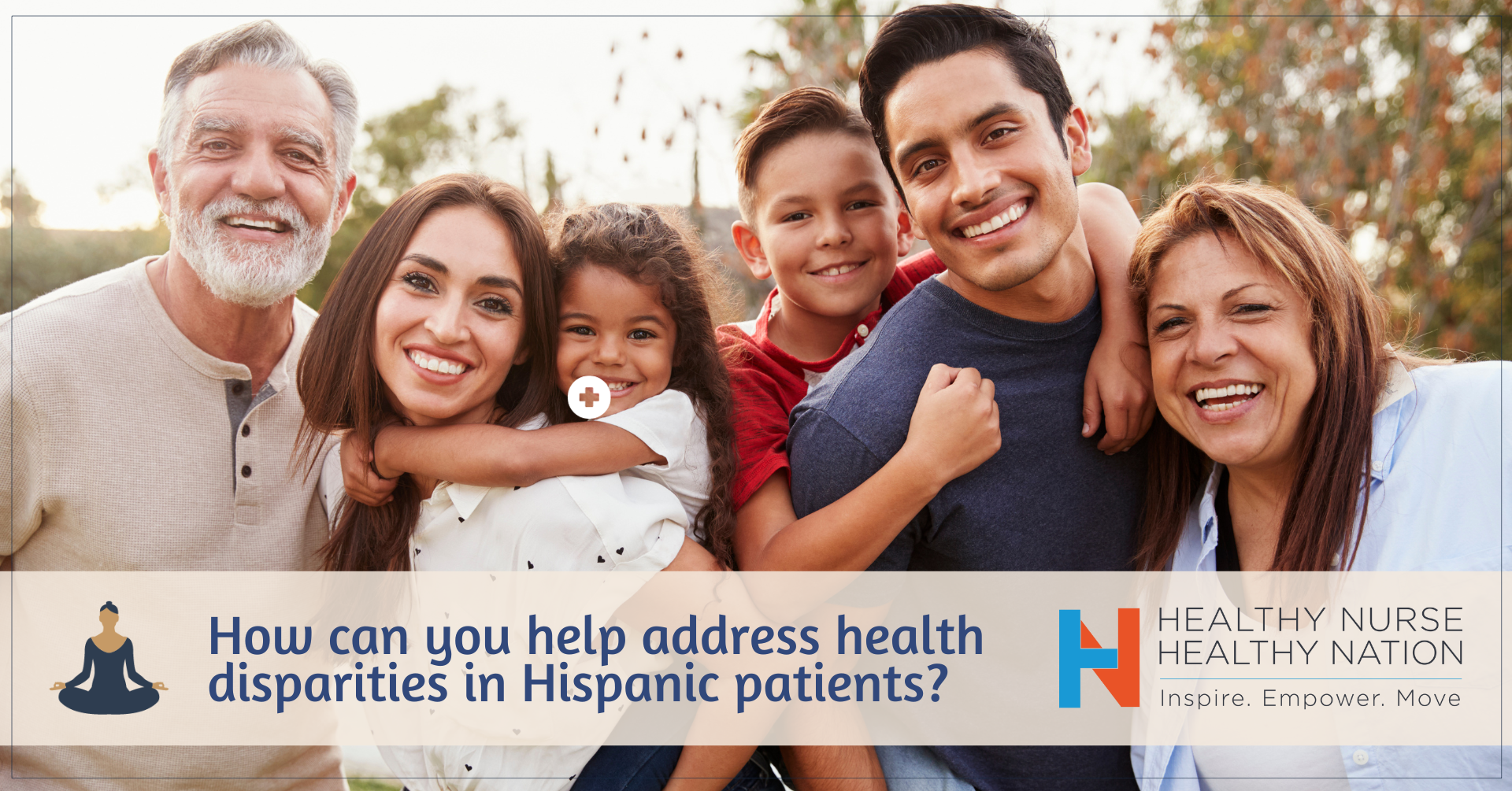Healthy Nurse, Healthy Nation™ Blog - 5 ways health professionals can help address health disparities In Hispanic patients
The Hispanic population is growing in the United States. Hispanics account for roughly 19% of Americans — the largest minority group in the U.S. But Hispanic adults are the least likely ethnic or racial group to have health insurance or get preventive care. And their health outcomes reflect that.

According to Giovanna Cecilia De Oliveira, PhD, MSN, RN, ANP-C, PMHNP-BC, Hispanics have several disparities in health outcomes that span both physical and mental health. Dr. De Oliveira is the Associate Professor of Clinical at the University of Miami, and she is dedicated to diminishing the health disparities among the Hispanic population. She recognizes that large-scale change needs to come from organizations and communities. But she also understands the power of nurses.
Non-medical factors, including income, education, and where you live, affect every person’s health, and are associated with health disparities. These factors, called social determinants of health (SDOH), can affect access to nutritious food, health insurance, and quality health care.“We need to focus on the individual,” Dr. De Oliveira says. “Nurses can make a difference at the individual level, and if all nurses embrace the idea of improving health equity for Hispanics, we’ll start to see it happen.”
Why Do Health Disparities Exist in the Hispanic Population?
Hispanic health is shaped by many of these factors. “Hispanics tend to have lower educational levels, which lead to lower-income jobs, which lead to being underinsured or uninsured or living in a place without access to quality health care.”
Dr. De Oliveira says, “Limited English proficiency can greatly affect engagement in health care.” It can limit:
- Access to health
- Communication with providers
- Understanding of the medical treatment
- Medication side effects
- Adequate follow-up
- Use of emergency services
That’s why it’s important to foster education in health care professions among Hispanics. Currently, only 9% of all RNs in the U.S. are Hispanic or Latino. And only 7% of all physicians and surgeons in the U.S. are Hispanic or Latino.
These SDOH, combined with language and cultural challenges, often keep Hispanics from participating in health-promoting behaviors and preventive care. They tend to have less access to:
- Nutritious food
- Prescription medication
- Preventive screenings
- Follow-up appointments
- Prenatal care
Health Outcomes and Hispanics
Without the proper preventive or ongoing care, Hispanics are at increased risk of developing chronic conditions that negatively impact health outcomes.
Hispanics have worse health outcomes for chronic physical conditions, including:
- Cancer
- Diabetes
- HIV
- Hypertension
- Kidney disease
- Obesity
- Sexually transmitted diseases
They also struggle with mental health. They are more likely to develop:
- ADHD
- Anxiety
- Bipolar disorder
- Major depressive disorder
Yet only 36% of Hispanics in the U.S. receive mental health services compared to 52% of non-Hispanic whites. “When it comes to mental health, you need to consider the cultural stigma within the Hispanic culture,” Dr. De Oliveira says. “We don’t like to express how we feel or think to others, especially to someone who does not share our culture. And that impedes the mental health care Hispanics receive.”
How Can Nurses Address Health Differences With Hispanic Patients?
Taking small steps to understand and address the needs of Hispanic patients can help diminish the disparities they experience.
Dr. De Oliveira encourages nurses to:
Acknowledge cultural diversity and learn about the Hispanic culture
Providing care for minority populations begins with recognizing their differences. According to a survey conducted by Pew Research Center, 44% of Hispanic Americans believe their health disparities stem from communication problems caused by language or cultural differences.
To educate yourself about the Hispanic population, you can:“Cultural diversity is something that many nursing schools don’t teach,” Dr. De Oliveira says. “But we need to understand cultural diversity to respect the differences in the values and norms of others.”
- Ask your organization for more cultural training specific to the population you serve
- Go to your local health department to learn what resources and help exist for Hispanics in your community
- Read about how to be culturally proficient with Hispanic patients
Be proactive with health screenings for Hispanics
Language barriers and social determinants of health may keep Hispanics from understanding the importance of screenings, ongoing treatment, and follow-up.
“Hispanics tend to minimize or avoid disclosing physical and mental illness symptoms,” Dr. De Oliveira says. “So nurses should be proactive when encountering Hispanics with social disparities. Look for signs of depression. Utilize family members or an interpreter to stress why preventive action is important.”
Take steps to put Hispanic patients at ease
Small gestures can signify your respect and recognition of cultural differences. “Building rapport with your Hispanic patients can make them comfortable and encourage them to disclose their physical and psychological stress,” Dr. De Oliveira says.
She adds that Hispanic patients may respond well to:
- Addressing them respectfully using “Mr.” or “Mrs.” instead of first names
- Direct eye contact and holding their gaze
- Recognizing the importance of religion and introducing prayer when appropriate
- Simple language on a 3rd-grade level
- Soft voice, especially when speaking with youth and older Hispanics
- Therapeutic touch, but asking for permission first
Help Hispanics navigate the health care system
Hispanics with a language barrier or insurance challenges may feel uneasy about seeking health care. That’s why it’s important to help them establish a bilingual primary care provider. Only 68% of Hispanic American adults and 50% of recent Hispanic immigrants have a primary care provider. About 18% of Hispanics do not have health insurance, compared to about 5% of non-Hispanic whites.
“Refer patients to a bilingual or culturally sensitive health care provider or clinic, when possible, especially if you notice a language barrier,” Dr. De Oliveira says. “Put them in the care of someone who can help them with referrals and navigating our health care system, which may be new to them.”
If a bilingual provider is not an option, there are several language assistance services available including:
- In-person interpretation: Face-to-face interaction allows the interpreter to read facial expressions, react to body language, and interact directly with providers and patients.
- Telephonic interpretation: Remote interpretation allows patients and providers to use either speakerphones or headsets to access language services.
- Translation of written materials: Providing patients with important written information in their own language gives them the ability to review and process the information.
Get involved at a higher level
There are several ways that nurses can get involved regionally and nationally to help decrease health disparities:
- Actively promote change: Get involved with nursing associations and national organizations working to promote laws and regulations to diminish health disparities and eliminate social inequality.
- Apply to the Minority Fellowship Program: The Substance Abuse and Mental Health Services Administration (SAMHSA) offers a Minority Fellowship Program (MFP) that encourages minority mental health professionals to work within their cultural communities and will pay for their higher education.
- Engage other nurses: Organizations like the National Commission to Address Racism in Nursing offers interactive learning and forums through Project ECHO® on Racism in Nursing. This free program provides an opportunity to learn and discuss health equity issues with other health care professionals.
How do will you support the health of your Hispanic patients?

Not a member of Healthy Nurse, Healthy Nation (HNHN) yet? Join today!
Sign up for our monthly challenges!



Post a Comment or Question